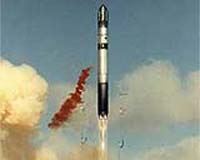 |
Kourou, French Guiana (SPX) May 14, 2009 Arianespace's heavy-lift mission with two satellite passengers that will help unlock some of the universe's mysteries has moved to the launch zone in preparation for liftoff tomorrow morning, May 14. The Ariane 5 rolled out of its final assembly building this morning (May 13) at 8:30 a.m., and was greeted by skies that were especially sunny for the month of May in French Guiana. After its transfer, the vehicle was secured in place on the ELA-3 launch zone at Europe's Spaceport. This clears the way for final pre-launch preparations and the countdown to a rare morning liftoff tomorrow at 10:12 a.m. (local time in French Guiana). The unusual mission timing is due to Ariane 5's deployment of its Herschel and Planck passengers on a trajectory that will take them to the Sun-Earth system's second Lagrange point (L2), where they are to carry out their scientific missions. Ariane 5 will deliver the spacecraft on an injection orbit with an apogee of nearly 1.2 million kilometers. At this distance, Herschel and Planck will make their own maneuvers for the continuation to the L2 point, which is 1.5 million kilometers from Earth. For this second Ariane 5 mission of 2009, the launcher's payload lift performance will be 6,000 kg. - of which approximately 5,320 kg. Is the combined weight of the two payloads. The other mass includes the payload integration hardware and Ariane 5's SYLDA dual-payload dispenser system. Herschel will be the largest space telescope ever launched, and was conceived to provide astronomers with their best views of the universe at far-infrared and sub-millimeter wavelengths. With a liftoff weight of 3,400 kg., Herschel carries a 3.5-meter-diameter mirror that will collect data for studies on the formation of stars and galaxies. The 1,920-kg. Planck observatory is designed to scan the sky in nine wavelength bands, and is equipped with a telescope that has an effective aperture of 1.5 meters. Data provided by this spacecraft will help determine the universe's fundamental characteristics - including the overall geometry of space, the density of normal matter and the rate at which the universe is expanding. Planck and Herschel were developed in the framework of the European Space Agency's space science program. Both spacecraft were built by Thales Alenia Space-led industry teams. Share This Article With Planet Earth
Related Links Arianespace Launch Pad at Space-Travel.com
 SSTL And ISC Kosmotras Celebrate Anniversary Of First Dnepr Launch
SSTL And ISC Kosmotras Celebrate Anniversary Of First Dnepr LaunchLondon, UK (SPX) May 14, 2009 SSTL and ISC Kosmotras are celebrating 10 years of successful cooperation, since the SSTL minisatellite UoSAT-12 made history as the first successful orbital injection by the Dnepr launch vehicle in April 1999. Director General of ISC Kosmotras, Vladamir Andreev explained the importance of the launch: "This occasion is a remarkable event in the activity of our two companies. For SSTL, this ... read more |
|
| The content herein, unless otherwise known to be public domain, are Copyright 1995-2009 - SpaceDaily. AFP and UPI Wire Stories are copyright Agence France-Presse and United Press International. ESA Portal Reports are copyright European Space Agency. All NASA sourced material is public domain. Additional copyrights may apply in whole or part to other bona fide parties. Advertising does not imply endorsement,agreement or approval of any opinions, statements or information provided by SpaceDaily on any Web page published or hosted by SpaceDaily. Privacy Statement |